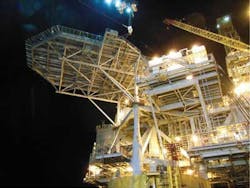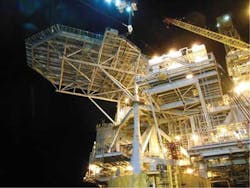Gulf brownfield project addresses safety challenges and solutions-full
Jason D. Cardon
Jacobs Engineering
Floating production projects are continuing to move forward in theGulf of Mexico (GoM) at a robust pace; and in addition to announced greenfield projects, an increasing number of brownfield developments are being undertaken.
Many of these developments have subsea completions tying back to existing floating infrastructures that serve as host production facilities. These brownfieldtiebacks use new subsea manifolds, risers, umbilicals, and flowlines. They can be a preferable option as a means of expanding production capacity or extending the life of existing floating facilities.
Subsea tiebacks optimize capex by using as much existing infrastructure as possible while still trying to maximize the profitability of capital projects.
Brownfield versus greenfield
Brownfield production expansion projects differ greatly from greenfield work. Greenfield topsides facilities can be engineered to be discrete, self-contained modules, capable of being lifted in place onshore and transported as part of an integral floating structure or floated offshore to be lifted into their final position.
Alternatively, brownfield tieback projects often require extensive offshore modifications to the topsides production capabilities on the hub facility. This is especially true if there were previous capacity increases. Brownfield project work can have unique safety issues with project execution being done simultaneously alongside ongoing facility operations. As is the case on greenfield projects, safety precautions and code adherence are important on all brownfield project phases, from front-end engineering and design (FEED) through commissioning.
In modifying or retrofitting an existing structure in brownfield work, engineers and designers must evaluate the existing infrastructure and meld new capabilities conforming to current industry safety standards. Appropriate equipment, industry safety requirements, and increased production capacities often need to be inserted into an existing deck layout in which less suitable equipment is demolished or dismantled to make room for the new additions.
Weight management is also a significant part of a brownfield tieback project. Subsea tieback flowlines and umbilicals, larger production equipment, and additional manpower capacity increase topsides weight, and can alter its center of gravity (Cg), impacting topsides structural stability and hull buoyancy. To maintain the lightest topsides weight and remove weight while making multiple modifications and additions, constant weight monitoring and minimization efforts are required during the design and every subsequent phase of the project.
Shutdowns might be required as some of the brownfield work cannot be done while the platform is in operation, but since extended shutdowns for platform reconfiguration or refurbishment curtail production, time and schedule are of the essence. Extensive front-end planning, constructability assessments, and increased engineering efforts are necessities. New and replacement equipment footprints must be exact. Hazard assessments (HAZIDS) need to be conducted to identify and mitigate potential health, safety and environment (HSE) risks for construction and operating worker safety.
Increased personnel onboard requires constant attention and assessment in order to maintain a safe number of construction workers interacting in close proximity with operating personnel in a facility designed primarily for operations only. Ongoing simultaneous operations reviews (SIMOPS) help operating and construction personnel perform critical tasks while working safely together in confined spaces.
Addressing operations and safety
The Royal Dutch Shell plc-owned and operatedAuger TLP facility, producing since 1994 in more than 2,800 ft (853 m) of water in Garden Banks block 426, approximately 225 mi (362 km) southwest of New Orleans, has accommodated seven subsea tiebacks. The most recent, due to be completed in 2014, ties-in the Cardamom development in adjacent block 427 with a subsea system that includes up to five subsea wells, a dual 8-in. flowline, and an umbilical.
In addition to the subsea infrastructure, Cardamom required significant modifications to the existing Auger topsides facilities. Jacobs did the engineering, design, and procurement on the alterations needed to add Cardamom's field production to Auger. The project team was involved in all constructability reviews, HAZIDs, leadership visits, and design/build interface. Major topsides changes required demolition of existing structures including a helideck, motor control center building, high pressure nitrogen storage system, chemical injection systems, and test separator with installations of newer structures and equipment as replacements.
Weight and space influences
Weight and space considerations on the Auger facilities were critical in adding production capacity while maintaining the overall topsides footprint and stability. Weight distribution and Cg issues were under constant review during all design phases and were a major part of the project management emphasis. Throughout multiple demolition and installation phases, equipment arrangements were adjusted, necessitating temporary relocations. Extensive pre-planning and continual monitoring assured that weight was minimized and that onboard personnel safety issues and risk avoidance were addressed while this work was performed.
Constructability and safety
All major equipment additions and modifications involved safety considerations in design, removal, and installation. Jacobs provided the offshore demolition and installation crews with 3D Plant Design Management Safety (PDMS) model drawings taken from laser scans so they could readily understand and follow the sequential removal and installation procedures.
With the exception of shut-ins for demolition, space creation and equipment installation for capacity expansion, the facility was in full production. Even during the shut-ins, maintenance and platform integrity work were ongoing, making SIMOPS planning and management essential.
Among the major modifications and their safety solutions included:
Flowline coolers addition. With space at a premium on this existing facility, the only available space to install 16 new flowline coolers was in an area vacated in the facility's well bay by removing and relocating existing wells and flowlines. It was decided that the safest installation would be to construct a 40 ft (12 m) tall by 30 ft (9 m) wide by 15 ft (5 m) deep support structure onshore for a single lift and install.
This decision eliminated a "stick-built" installation with extensive hot work over water in the confined well bay. Leading-edge laser scanning and 3D modeling assured the exact dimensions of the structure before it left the fabrication yard and its correct positioning on the barge to facilitate a straight lift into its final position. For safety and fit, scanning was done of the offshore work area to eliminate any structural or piping clashes, and to ensure the well bay was of sufficient size for the new equipment's installation.
Vertical guide rails, installed in the well bay, maximized the safe installation of the structure, allowing it to freely ride down the rails without lateral movement while fully supported by the crane hook. Tugger winches assisted the frame into its final position. Precise design and extensive planning provided a safe means of installation with minimal human intervention and assured that no personnel were working under the suspended structure.
MCC building installation. The Cardamom upgrade removed an existing subsea infrastructure motor control center (MCC) structure, replacing it with a new, larger 23-ton building. Strict lock out/tag out procedures conforming to company and industry standards assured that construction personnel were further protected during demolition and installation.
After temporary relocation of a deck section, air compressor and air dryer cylinders, the new MCC building was placed by the deck crane on pre-calculated, precisely placed I-beam cribbing for installation with extremely tight clearances. No personnel were allowed under the suspended load; rather, tugger winches maneuvered the building into its final position. Operations and deck coordinators secured the area during relocations, demolition, and installation, ensuring that personnel worked at a safe distance from the building until it was finally positioned.
Helipad replacement. Safe and rapid egress from a floating facility is a major consideration for personnel safety. The new helideck design replaced a small primary deck and separate parking helideck, and combined them into a larger, single deck with increased capacity for larger helicopters to facilitate expedited crew changes, if needed. Ingress and egress were improved with a design that widened the stairway to accommodate a stretcher, and all helicopter flight operations were moved closer to the living quarters, eliminating the need to walk through the process areas. To aid in safe baggage handling and equipment drayage, an automated baggage handling system was designed and installed so crew members could focus solely on maintaining a three-point contact while climbing to the helipad or disembarking.
The helideck installation relied on laser scanning for pre-planning onshore and placement of stabbing guides offshore, assuring a precise alignment and positioning of the four-legged structure with only minimal worker involvement. Center of gravity adjustments with counterweights assisted rigging configuration and set-down reactions to keep the helideck structure safely in compression. Safety hooks and tension struts added stability to the helideck's rear legs for safe and expedited welding without the possibility of uplift.
Conclusion
It is imperative for safety to be an integral part in the design, construction, and installation of operating features in a brownfield facility. A safety mindset needs to be embedded in the culture of all participating companies, shared by all who are involved in a project.
The results of any project's focus on eliminating hazards should be verified through safety and constructability reviews and HAZIDs executed early on in the project before the detailed design is frozen. Buy-in from operations, HSSE, construction and engineering is necessary before going forward.
Precautions to avert safety incidents must be implemented into the design with a heavy focus on the fabrication and construction phases of the project. Pre-planning for accident aversion also needs to be part of the engineering and design scope of work for all facets of the project, including onshore lifting/loadout, transportation, offshore lifts, demolition of existing equipment and systems, installation, commissioning, and life cycle operation. In addition to the oversight by experienced engineers and constructors, early engagement of operations management, fabricators, and vendors in the design will help maintain a safe brownfield project.
The Auger/Cardamom tie-in project was not typical. It was complex and presented numerous safety challenges, such as weight and stability issues, tight tolerances, and large structural and equipment additions. Solutions included innovative use of laser scanning technology, pre-planning with HAZIDs and constructability reviews, weight mitigation efforts, and continual interface on safety issues with all project participants. Video conferencing was frequently used to link design with operations and construction, keeping participants connected in real-time and minimizing offshore flights for "non-essential" personnel. Shell's and Jacobs' compatible company-wide safety cultures and initiatives positively impacted the project's total safety awareness, incorporating safety values and processes into every phase to produce solid project results.

